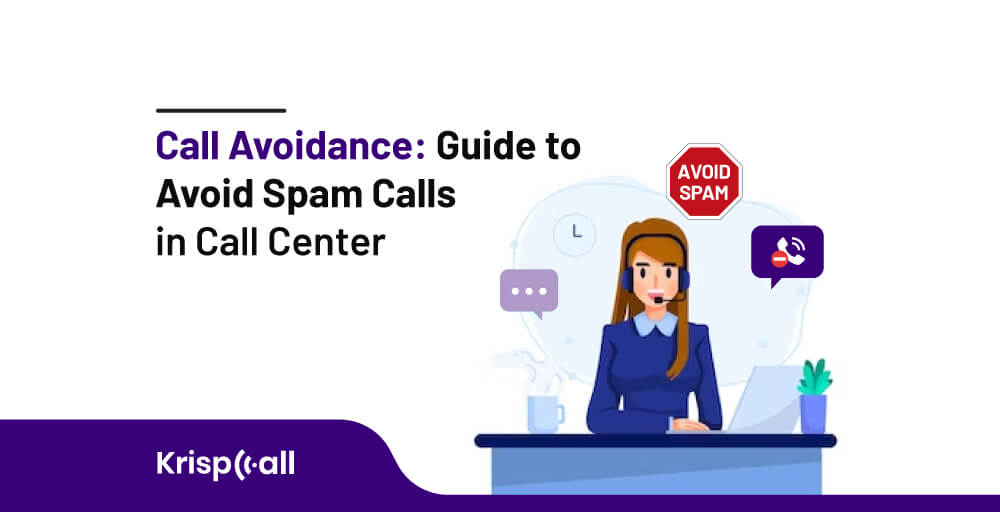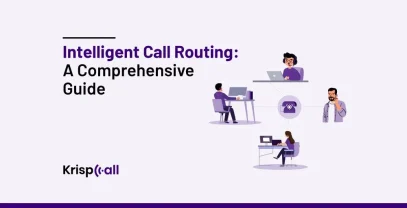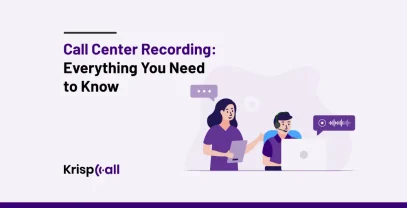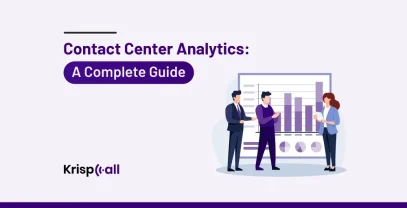The nature of the job of a call center is typically challenging, and employees who work in that are some of the most stressed and busiest ones.
They continue with their jobs on a daily basis, answering queries, giving solutions to angry customers 😡, and facing spam calls, all while piling up the frustration.
Once a limit is reached, they begin to get drained and opt to avoid calls. And that’s where call avoidance becomes real!
So, with that in mind, here’s a question: 🤔 Are you a call center supervisor/manager looking to get rid of call avoidance and spam calls altogether?
Here, in this guide, we’ll discuss call avoidance, its relevance in call centers, its consequences, strategies, and tips to counter it, as well as how VoIP solutions can be used to eliminate it.
🔑 Key Takeaways from the Article
- Call Avoidance means intentionally leaving calls unattended.
- There are several negative effects of call avoidance on a call center/contact center’s overall performance.
- You can use strategies like providing guidance to your agents, implementing self-service portals, omnichannel service delivery, and changing call routing protocols to handle call avoidance in your contact center.
- Spam calls often lead to call avoidance in call centers and can be swiftly dealt with.
- Using cloud telephony services like KrispCall helps you reduce call avoidance.
Let’s get going!
What is Call Avoidance?
Call Avoidance, A.K.A Interaction Avoidance is a practice or a strategy that business representatives, especially call center agents, use to avoid answering calls or other forms of customer contact intentionally.

Here are some actions that can be considered Call Avoidance examples:
- Leaving the phone unattended.
- Taking excessive breaks or downtime.
- Transferring calls frequently or taking too long to resolve them.
- Staying connected with a customer even after their issue has been solved.
- Intentionally holding or muting customer calls.
What is Call Avoidance in a Call Center?
Call avoidance in a call center refers to when call center agents deliberately avoid receiving or making calls, it means actions that are intentional or unintentional of contact center agents and supervisors taken to avoid receiving inbound calls or making outbound phone calls.
These actions by contact center personnel, based on whatever motive, often lead to decreased customer service, longer wait times, and frustrated customers, and they result in operational inefficiencies.
What are the consequences of ignoring spam calls in a call center?
We know call centers are often overrun with such concerns, and you should know that there’s always an opportunity that a real customer’s call may get mixed and then missed. So remember that ‘Not all calls that feel like spam are spam!’
If not taken care of, a bundle of those could pile up and then lead to some unforeseen consequences.
So, to give you an idea of what it can lead to, here’s a list of the outcomes of ignoring spam calls in a call center.
- Several leads or calls that were intended for legitimate business may be mistaken for spam and ignored, resulting in lost sales or dissatisfied customers.
- Ignoring spam all the time can increase call volume and disrupt agents’ workflow, leading to stress, decreased productivity, and potentially higher attrition rates.
- Customers may feel neglected and frustrated when genuine calls are ignored in a “spam-heavy” environment, decreasing customer satisfaction and loyalty.
- Lastly, The number of spam calls may increase, as the callers will simply target the same number again if you do not answer them.
10 Strategies to Handle Call Avoidance in Call Center in 2024
Remember that dealing with call avoidance requires more than one approach.
To do that, start by understanding the ‘why’ behind it. Are agents overwhelmed? Is the technology clunky? Then, tailor your strategy.
And once you’ve got your mind set on that, here are the effective tactics that you can employ:

1. Track Down the Origin of the Cause
The first strategy you need to identify and follow is pinpointing the origin of the trouble. Call avoidance is sometimes done consciously or deliberately, and unintentional laziness but rather out of a sense of necessity.
Understanding the cause is crucial for crafting an effective solution for all parties, including customers. So, even before starting to tackle call avoidance, understand why it’s happening. Is it agent burnout, complex calls, or lack of motivation? Once you know the cause, just eliminate it!
2. Provide Clear Guidance to Agents
Another good strategy to get going with is setting up a clear call avoidance policy & expectations and then guiding the agents according to that. This should be done well on your part, and to do that, provide agents with the right tools, knowledge, and resources they need to excel.
With the right resources in hand & information on do’s and don’ts, your agents will automatically feel confident and capable and be less likely to shy away from challenges and avoid calls, thus resulting in lower call avoidance.
3. Implement Self-Service Options
Next up, you may want to introduce self-service support such as FAQs, online information portals, articles in the knowledge base, and an automated call response system. This provides customers with alternative ways to find information and resolve issues, reducing the need for phone calls.
So proportionally, if the number of calls is reduced, the call avoidance rate will also drop, and you don’t have to worry about that. This will likewise optimize the workload, reduce agent anxiety, and improve the overall productivity of the call center.
4. Change the Call Routing Protocol
Another anti-call avoidance strategy is to not let calls land on the wrong desks. But what does that mean? It means to implement a routing system that matches call center agent expertise with customer needs.
Once the system is up, customer calls will automatically be routed to the right representative who can handle it swiftly & effectively, and other agents who are free at the time ‘will have’ to respond to new incoming calls no matter what.
5. Automate where Possible
You know, most modern call center software has the ability and is designed to automate the most mundane of tasks. So why not utilize those? One example is utilizing automated call distribution systems to ensure fair and efficient call routing.
You can also use IVR systems to gather basic information, offer self-service options, and route calls intelligently, as well as implement call recording and analysis tools to identify patterns and areas for improvement.
6. Use Omni-Communication Channels
57% of customers prefer to engage companies through digital channels! – A Salesforce study says this, and what does it mean? The answer is simple- customers want to interact with companies through other contact methods apart from calls and omnidirectional.
So why not purge the call avoidance rate through it, i.e., through email, SMS, social media, self-service, etc? And as consumers will have other ways to reach out to businesses and resolve their issues, the call centers as a whole can get going with their regular work without worrying about call avoidance.
7. Monitor and Track Performance
To effectively complete given tasks, certain calls need to be monitored and followed up on by supervisors or higher-ups. For this to work, you should regularly analyze call avoidance rates, call handling times, and customer satisfaction metrics.
Identify trends and implement corrective measures wherever and whenever needed; you can also opt to collect customer feedback on their call experiences and conduct surveys to identify areas for improvement and address potential sources of call avoidance issues.
8. Avoid a Strict Call Avoidance Policy
A call avoidance policy should indeed be well thought out, but remember that it shouldn’t be rigid either. With the implementation of such a tactic, try to create a collaborative environment where agents and supervisors work together to address the underlying issues that lead to call avoidance without putting excessive pressure on the agents.
An environment that fosters open communication, celebrates progress, and addresses concerns on time, helping employees stay engaged and continuously do their work correctly, i.e., not avoid calls.
9. Recognize and Reward
Acknowledge and celebrate agents who consistently go above and beyond. Implement incentive programs and public recognition systems to show appreciation for their hard work and dedication to help avoid burnout and increase engagement. Also, note that recognizing and rewarding boosts employee morale and encourages them to show consistent commitment.
That can be said to be a fact as per a report by Reward Gateway, which says 60% of employees want their employer to increase their investment in employee reward and recognition.
10. Continuously Improve and Adapt
Finally, as followed in all strategies, you should improvise and adapt to the given situation. The call center market is vast and incredibly competitive, and call avoidance hinders its effectiveness.
In other words, the best way to stay ahead while countering call avoidance is to stay informed about industry best practices and emerging technologies. Regularly re-evaluate your call avoidance strategies and adapt them based on your evolving needs and customer preferences.
Tips & Tricks to Prevent Spam Calls among Call Center Agents
There is no doubt that call center agents always go through a considerable number of spam calls that hinder their overall productivity as well as the organization as a whole.

So, how do we get rid of those? That said, for that, you can follow these handy call avoidance tricks and tips:
- To detect spammers, verify your contact lists by checking Do Not Call registries and checking for cell phone numbers.
- Set up IVR menus to detect and avoid spam and then filter out those to improve the call center’s productivity and efficiency.
- You can also utilize call-blocking databases and anti-spam software to block out known spam numbers before your agents even see them.
- Provide your agents with the knowledge to identify suspicious & spam calls by themselves, such as unclear scripts and robotic voices.
- To prevent unintentional spam, it is equally important to review your call data to identify patterns and adapt your approach.
Improve agent efficiency with VoIP by curbing call avoidance
As far as dealing with call avoidance in your call center, you can choose any option that you deem right and get the desired result. While there are many methods to do so, one option that is near-perfect to serve this cause is VoIP.
With a voice-over IP solution for your business, you can make use of all the advantages that are associated with it to curb this issue while empowering your agents to deliver exceptional service to your customers.
Through a virtual telephony system, you usually get features like self-service options that include IVR, a variety of call transfer mechanisms, and chatbots that even out and reduce the pressure on agents. Also, you have other options like call analytics to monitor agent performance and dashboards to feed you information about the KPIs you’ve set and use those to identify examples of call avoidance behavior.
How to use KrispCall to combat call avoidance in call centers?
When it comes to virtual phone systems, there’s simply no better alternative than KrispCall. With it, businesses with call centers can have all the necessary tools to minimize call avoidance and then build a win-win situation for their customers as well as agents.
KrispCall’s cloud telephony system is almost a complete one, and here’s how all of its features work together to help you combat call avoidance and get rid of bad calls:
- Call Analytics: It lets you analyze all calls in real-time, identifying potential issues or lengthy wait times before they escalate into bad calls.
- IVR for Self-Service: It allows customers to connect to the right teams themselves through interactive voice menus, reducing bad call volume and freeing agents for complex inquiries.
- Call Monitoring: For discreetly observing agent calls to check if they are practicing call avoidance or to identify areas for improvement or celebrate successes.
- Ring All Devices: With this feature, agents can always be available to answer calls from all devices simultaneously, increasing response times, maximizing call coverage, and minimizing the time wasted on bad calls.
- Agent Groups: This can help organize agents into specialized teams based on expertise, ensuring customers are connected to the right agent for their needs the first time and the calls don’t get dropped off or get converted into bad calls.
🎇 Get a Free Demo of KrispCall Today
The Wrap-up!
To sum things up, contact centers must address the problem of call avoidance before it becomes a major problem, and if not done, it can hinder the success of a call center.
Moreover, as we’ve discussed in this article, you can implement all the strategies and tactics or use other solutions like KrispCall, which has all the features and capabilities you can take advantage of to combat call avoidance to ensure that your agents aren’t overburdened and that your call center operates efficiently.
Even though call avoidance should be addressed, contact center managers should also be wary of its consequences and the methods they use to minimize it, or else it can have negative impacts of its own. They should prioritize understanding its root causes to create a positive customer experience and ensure the well-being and satisfaction of their agents.





